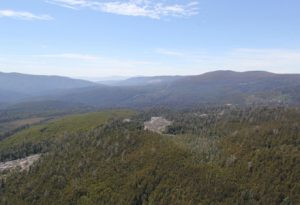
This month the Australian and Tasmanian Governments agreed to extend the Tasmanian Regional Forest Agreement (RFA) for a further two decades. Source: Timberbiz
Tasmania’s forests have long been the lifeblood of the state, providing jobs and economic opportunities to thousands. However, protecting the state’s unique environment has always been important to ensure that Tasmania’s forests can continue to be enjoyed by the community for generations to come.
The RFAs are 20 year agreements between state and federal governments that allow logging of native forests on public land and are designed to bring certainty for the timber industry.
The Australian Forest Products Association (AFPA) strongly welcomed the announcement with CEO, Mr Ross Hampton, saying the extension maintains the existing production forest area, and updates language in the agreement to better reflect the modern forest products industry.
“Today’s announcement is a major endorsement and recognition of our industry’s contribution to the Australian economy, with an annual turnover of $20 billion, directly supporting around 120,000 jobs across the whole value chain, and an additional 180,000 jobs through flow-on economic activity,” Mr Hampton said.
“We congratulate the Tasmanian and Federal Governments for acting decisively to extend the Tasmanian RFA and provide certainty to one of the state’s largest employers and a vital part of the national value chain – Tasmania accounts for 28% of Australia’s native hardwood harvested by volume, and 20% by value.”
Mr Hampton said the national RFA framework sought to balance environmental, social and economic considerations in the management of our forest estate, but while environmental objectives had been met and exceeded, certainty for industry had not been met.
“It is vital that we see a 20-year extension across all RFAs without further delays to provide the certainty of resource supply necessary for industry to remain competitive, encourage investment and innovation, and underpin jobs,” Mr Hampton said.
The previous RFA process resulted nationally in the transfer of more than 2 million hectares of forest to reserves, and subsequent decisions taken by states and territories have further increased the area of forests in reserves to around 3 million hectares.
In Tasmania, the RFA signing in 1997 (and the Tasmanian Community Forestry Agreement in 2005) resulted in a considerable increase in the state forest locked up in reserves, from 30.5% of the state’s forest estate in 1996 to 1.5 million hectares – or around 50% – today.
“Disappointingly, arbitrary decisions to reduce the area of production forests have occurred in all RFA regions in the past 20 years. In Tasmania, this been a massive hit on jobs in the industry, with the state’s forest industry almost halving from its peak of around 7000 direct jobs in 2008 to around 3600 today.
“AFPA will study the detail of the RFA extension, and we look forward to working with the Federal and other state governments to ensure that the RFA framework continues to deliver on all its objectives,” Mr Hampton said.
According to Prime Minister Malcolm Turnbull this agreement provides long term job security for thousands of Tasmanian families who rely on a sustainably managed forest industry for employment.
More than 3600 Tasmanians are currently employed by the forestry industry and the government says it wants to ensure it continues to create more employment opportunities for future generations.
The extended agreement aims to deliver a number of improvements to the RFA framework, including:
- rolling five-year extensions, subject to performance and review
- a more outcomes-focused review process—in line with international indicators and consistent with Australian and Tasmanian government State of the Forests Reports
- the inclusion of clauses on matters of national environmental significance, as defined by theEnvironment Protection and Biodiversity Conservation Act 1999 (Cth).
For more information visit http://www.agriculture.gov.au/forestry/policies/rfa/regions/tasmania







